Shaken beef transforms ordinary beef into an extraordinary Vietnamese culinary experience that’ll make your taste buds dance with joy. This iconic dish, known as bò lúc lắc in Vietnamese, gets its name from the vigorous shaking motion used to sear tender beef cubes in a blazing hot wok.
We’re obsessed with how this restaurant-quality dish delivers maximum flavor in minimal time. The secret lies in the perfect balance of sweet and savory marinade combined with high-heat cooking that creates those irresistible caramelized edges while keeping the center perfectly tender.
What makes our version special is the authentic technique that ensures every piece of beef gets that signature wok hei – the breath of the wok that professional chefs prize. You’ll serve this over fresh greens or steamed rice for a meal that rivals your favorite Vietnamese restaurant but comes together in your own kitchen in just 20 minutes.
What Is Vietnamese Shaken Beef
Vietnamese shaken beef, known as bò lúc lắc in Vietnamese, represents one of the most beloved stir-fry dishes in Vietnamese cuisine. We describe this dish as tender cubes of beef that are quickly seared at extremely high heat while being constantly “shaken” or tossed in the wok or pan.
The cooking technique involves cutting beef into uniform cubes and marinating them in a mixture of soy sauce, oyster sauce, garlic, and sugar. We then cook these marinated beef cubes over intense heat for just a few minutes, creating a perfect contrast between the caramelized exterior and the tender, juicy interior.
This signature “shaking” motion serves multiple purposes in the cooking process. The constant movement prevents the beef from sticking to the pan while ensuring even browning on all sides. We achieve the distinctive wok hei flavor through this rapid, high-heat cooking method that gives the beef its characteristic smoky taste.
Traditional Vietnamese restaurants serve bò lúc lắc over a bed of fresh watercress or mixed greens, often accompanied by sliced tomatoes and onions. The hot beef slightly wilts the greens, creating a perfect temperature contrast that enhances the overall dining experience.
The dish gained popularity in Vietnamese cuisine during the French colonial period, incorporating Western beef-cooking techniques with traditional Vietnamese flavors. We find that this fusion creates a unique flavor profile that balances sweet, salty, and umami elements while maintaining the fresh, vibrant qualities typical of Vietnamese cooking.
Modern variations of shaken beef include serving it over steamed rice, fried rice, or even as a filling for bánh mì sandwiches. The versatility of this dish makes it suitable for both casual family dinners and special occasions.
Essential Equipment for Making Shaken Beef

Creating authentic Vietnamese shaken beef requires exact equipment that enables the high-heat cooking technique essential to this beloved dish. We’ve identified the key tools that will help you achieve restaurant-quality results in your home kitchen.
Heavy-Bottomed Pan
The foundation of great shaken beef lies in selecting the right pan. Cast iron, carbon steel, or stainless steel pans deliver the superior heat retention and distribution needed for proper searing. These materials withstand the intense heat required to create the characteristic caramelized crust while maintaining even temperatures throughout cooking.
Nonstick pans should be avoided entirely as they cannot reach the high temperatures necessary for authentic shaking technique or proper beef searing. We recommend choosing a pan that can handle extreme heat without warping or losing its cooking properties.
High-Heat Cooking Surface
Your stovetop must generate sufficient heat to bring the pan to searing temperature before adding the beef. The pan needs preheating on high heat so beef cubes sizzle immediately upon contact, preserving their natural juices while developing the signature caramelized exterior that defines this dish.
Proper Utensils for Tossing
Sturdy tongs or a heat-resistant spatula become essential for executing the shaking motion safely and effectively. These tools allow you to flip and move beef cubes evenly without piercing the meat, which would release precious juices and compromise texture.
Sharp Knife and Cutting Board
Uniform beef preparation starts with quality cutting tools. A sharp knife ensures clean cuts through the steak, creating consistent 1-inch cubes that cook evenly and maintain their tender texture throughout the high-heat process.
Marinating Equipment
Proper mixing bowls accommodate the marinating process where beef combines with soy sauce, oyster sauce, garlic, sugar, and other flavor-building ingredients before cooking begins.
| Equipment Type | Recommended Materials | Purpose |
|---|---|---|
| Pan | Cast iron, carbon steel, stainless steel | Heat retention and even distribution |
| Cooking Oil | Vegetable or grapeseed (high smoke point) | Prevents burning during high-heat cooking |
| Utensils | Heat-resistant tongs or spatula | Safe beef manipulation and tossing |
The shaking action itself involves either literally moving the pan or using utensils to toss beef cubes, ensuring all sides sear quickly and evenly. This technique, combined with the right equipment, seals in the beef’s natural juices while developing the distinctive flavor and texture that makes Vietnamese shaken beef so memorable.
Ingredients
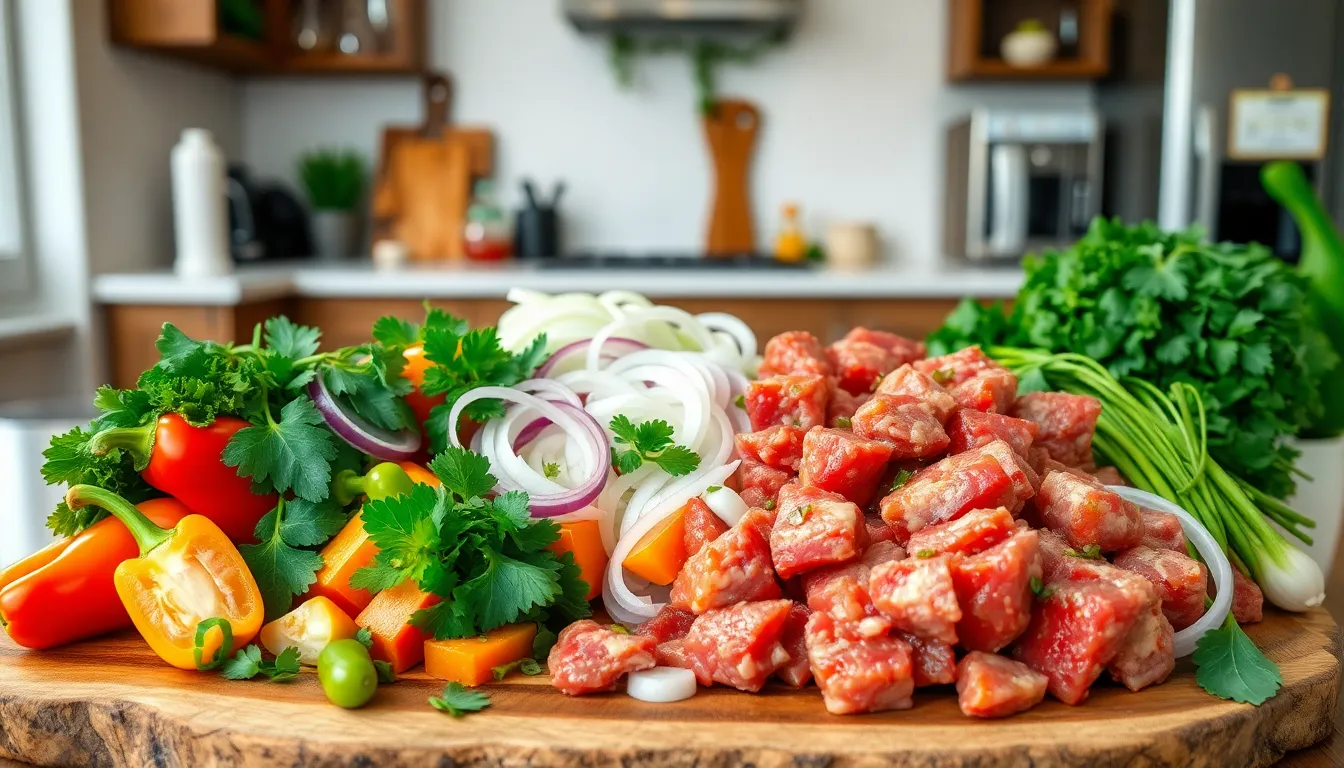
We’ve carefully selected each ingredient to create the perfect balance of flavors that makes Vietnamese shaken beef so irresistible. These components work together to build layers of umami and create that signature caramelized exterior with tender interior.
For the Beef Marinade
- 1 pound beef steak (ribeye, sirloin, or tenderloin), cut into 1-inch cubes
- 1 tablespoon soy sauce
- 1 to 4 tablespoons oyster sauce
- 1 to 3 cloves garlic, minced
- ½ to 1 tablespoon sugar
- ½ to 1 teaspoon ground black pepper
- 1 teaspoon cornstarch or tapioca starch (optional, for coating)
- 1 tablespoon sesame oil (optional)
- 1 to 2 tablespoons garlic oil or vegetable oil
- 1 tablespoon fish sauce (optional)
- Maggi seasoning or salt to taste
For the Stir-Fry
- 1 to 2 tablespoons vegetable oil
- 1 white or yellow onion, cut into large chunks
- 1 bell pepper, cut into large chunks
- 2 to 3 green onions, cut into 2-inch pieces
- Shallots, thinly sliced (optional)
- Fresh lettuce and tomatoes for serving
- Rice wine vinegar, sake, or water (optional, for added flavor)
For the Dipping Sauce
- 1½ tablespoons fresh lime juice
- 1 tablespoon salt
- 1 teaspoon freshly ground black pepper
Prep Work
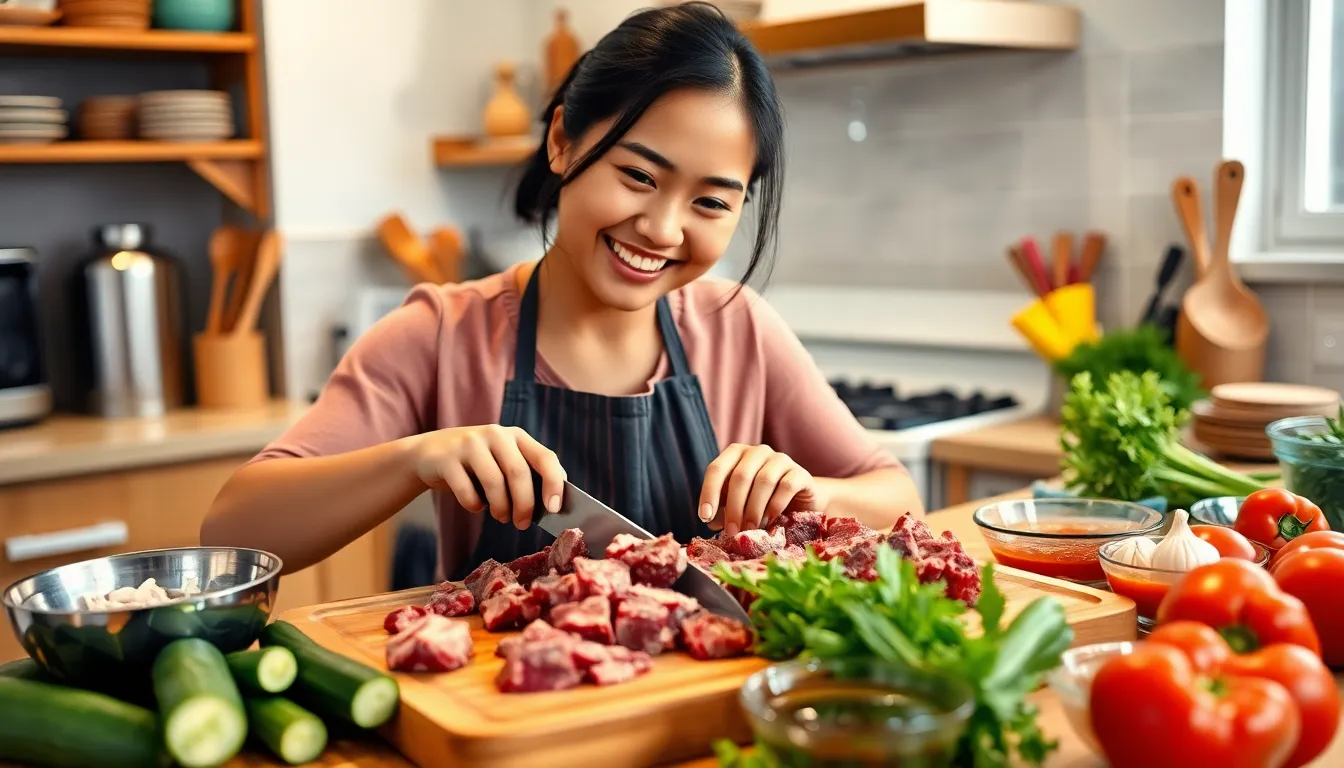
Proper preparation sets the foundation for authentic Vietnamese shaken beef success. We’ll organize our ingredients and equipment before cooking to ensure smooth execution during the high-heat searing process.
Preparing the Beef
We start by cutting our beef into uniform 1 to 1.5-inch cubes to ensure even cooking throughout. The key lies in maintaining consistent sizing so each piece develops the same beautiful caramelized exterior while staying tender inside.
Before marinating, we season the beef cubes generously with salt and pepper. This initial seasoning creates a base layer of flavor that penetrates the meat. Our choice of beef matters significantly—filet mignon, tenderloin, ribeye, or strip steak all work exceptionally well for this dish.
The beef should feel firm yet yielding when properly cut. We pat each cube dry with paper towels to remove excess moisture, which helps achieve better searing results later.
Making the Marinade
Our marinade combines several key ingredients that build complex layers of flavor. We whisk together 2 tablespoons of oyster sauce with 1-2 tablespoons of soy sauce as our umami foundation.
Next, we add 1-2 teaspoons of granulated or brown sugar to balance the salty elements and promote caramelization. We incorporate 3-4 cloves of minced garlic along with ground black pepper for aromatic depth.
Optional additions include fish sauce for extra umami, sesame oil for nuttiness, and a pinch of baking soda to help tenderize the meat. Some cooks add a touch of MSG for enhanced savory notes. We mix all marinade ingredients thoroughly before adding the beef cubes.
The marination time ranges from 10 minutes for quick preparation to overnight for maximum flavor development. We recommend at least 30 minutes for optimal taste penetration.
Preparing Vegetables and Aromatics
We slice one small yellow onion into half-moon shapes, keeping the pieces substantial enough to maintain texture during cooking. The onion slices should be roughly ¼-inch thick to prevent burning while allowing proper caramelization.
Green onions or scallions get cut into 1-2 inch pieces, providing fresh color and mild onion flavor. We separate the white and green parts, as the white portions go into the pan first due to their longer cooking time.
For serving accompaniments, we prepare fresh vegetables like cucumbers and tomatoes, cutting them into appealing shapes. These vegetables often rest on a bed of arugula, watercress, or lettuce to create temperature contrast with the hot beef.
Our aromatics preparation includes having minced garlic ready for sautéing after the beef sears. We keep all prepared vegetables organized and within easy reach since the actual cooking happens very quickly once we start.
Instructions

Now that we have our ingredients prepared and equipment ready, let’s jump into the cooking process that transforms simple beef cubes into the beloved Vietnamese delicacy. We’ll guide you through each step to achieve that perfect balance of caramelized exterior and tender interior.
Marinating the Beef
We begin by placing our 1 lb of beef cubes into a medium mixing bowl. Add 1-2 tablespoons of soy sauce to the beef, followed by 1-2 tablespoons of oyster sauce for depth and richness. Sprinkle in 1-2 teaspoons of minced garlic along with ½ teaspoon of sugar to help create that signature caramelization.
Season the mixture with black pepper to taste, ensuring every cube gets coated with the aromatic blend. For additional umami depth, we can incorporate a splash of fish sauce at this stage. Toss the beef thoroughly with our hands or tongs until each piece is evenly coated with the marinade.
Cover the bowl and let the beef marinate for at least 10-30 minutes at room temperature. This timing allows the flavors to penetrate the meat while keeping the beef at an ideal temperature for quick searing.
Making the Dipping Sauce
While our beef marinates, we prepare the bright and tangy dipping sauce that perfectly complements the rich flavors. Squeeze fresh lime juice into a small bowl, starting with the juice of one lime and adjusting to taste preferences.
Add salt and pepper to the lime juice, whisking gently to combine the seasonings. For enhanced complexity, we can include a small dash of fish sauce or a touch of honey to balance the acidity.
Taste and adjust the seasoning as needed, keeping in mind that this sauce should provide a fresh contrast to the savory beef. Set the finished sauce aside for serving.
Cooking the Shaken Beef
Heat our large skillet or wok over high heat until it begins to smoke slightly, indicating the proper temperature for searing. Add a generous amount of high smoke point oil, swirling to coat the bottom of the pan completely.
Working in batches to avoid overcrowding, add the marinated beef cubes to the hot oil. Allow the beef to sear undisturbed for 30-45 seconds before beginning the signature shaking motion. Shake the pan vigorously while tossing the beef with tongs to ensure even browning on all sides.
Cook each batch for approximately 2-3 minutes total, maintaining the high heat throughout the process. The beef should develop a golden brown crust while remaining medium rare to medium inside. Remove the cooked beef to a plate and set aside.
Reduce the heat to medium and add butter to the same pan, allowing it to melt and foam. Toss in our sliced onions and any remaining garlic, sautéing until fragrant and the onions begin to soften, about 1-2 minutes.
Return all the cooked beef to the pan and toss everything together with the aromatic onion mixture. Give the pan a final few shakes to combine all elements, then immediately remove from heat to prevent overcooking.
Serve the shaken beef immediately over fresh lettuce, tomatoes, and cucumbers, accompanied by our prepared dipping sauce.
Serving Suggestions
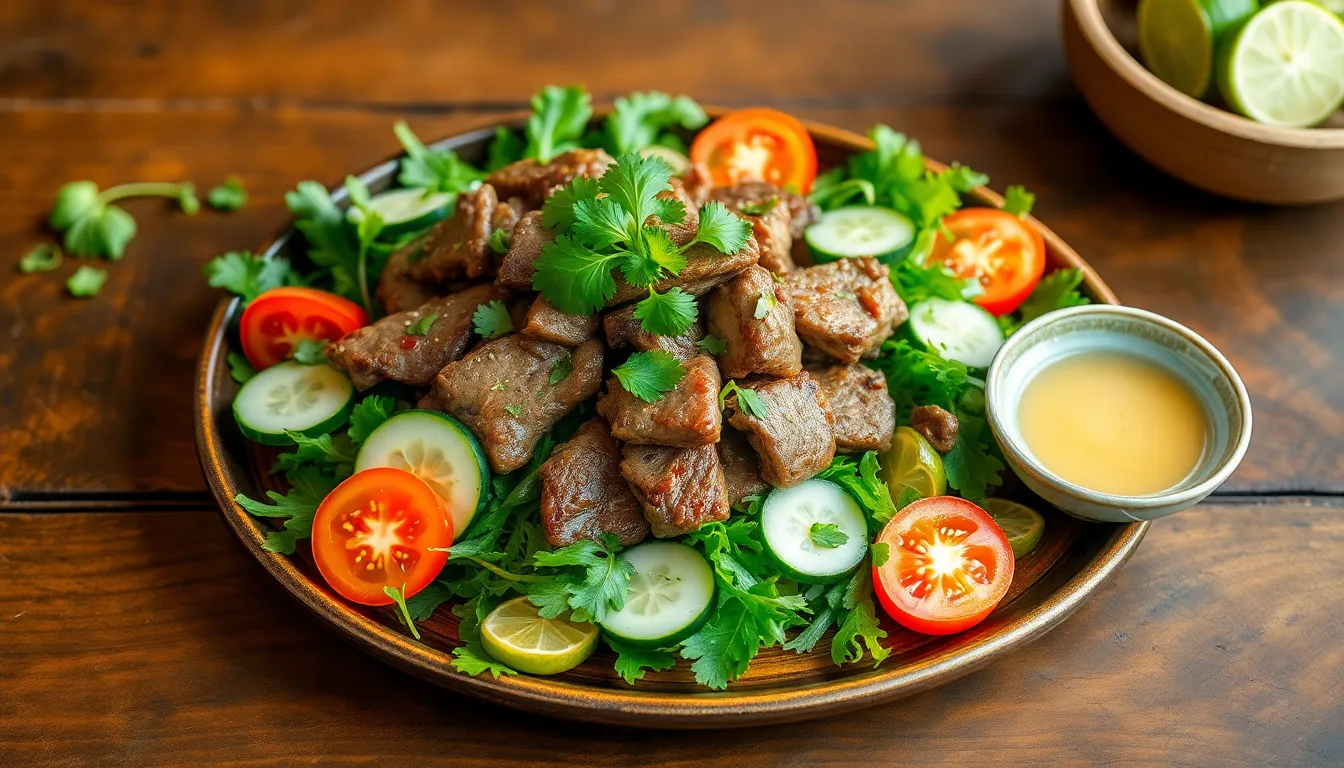
Vietnamese shaken beef truly shines when paired with fresh crisp greens that complement its rich savory flavors. We recommend serving the hot seared beef cubes over a bed of fresh watercress or arugula for an authentic presentation. The heat from the beef gently wilts the delicate greens while creating a delightful temperature contrast.
Fresh lettuce leaves make an excellent base for this dish alongside sliced cucumbers and ripe tomatoes. We love how these cooling vegetables balance the intensity of the caramelized beef. Arrange the vegetables on individual plates or create a family style platter for sharing.
Steamed jasmine rice provides a perfect neutral backdrop that allows the bold flavors of the beef to take center stage. We often serve tomato rice as a flavorful alternative that adds another layer of complexity to the meal. Plain white rice works equally well for those who prefer a more traditional approach.
The lime dipping sauce plays a crucial role in brightening each bite of the rich beef. We mix fresh lime juice with salt and black pepper to create this essential accompaniment. Some variations include adding a splash of fish sauce or a touch of honey for additional depth.
Fresh herbs elevate the entire dining experience when scattered over the finished dish. We recommend using cilantro mint or Thai basil to add aromatic freshness. These herbs provide a cooling effect that balances the warm spices in the beef.
For casual entertaining we suggest serving the shaken beef family style with multiple accompaniments. Guests can customize their plates with their preferred combination of greens vegetables and rice. This interactive approach makes the meal more captivating and allows everyone to enjoy the dish according to their preferences.
The dish also works beautifully as a filling for bánh mì sandwiches or lettuce wraps for lighter fare. We find that the versatility of Vietnamese shaken beef makes it suitable for both special occasions and weeknight dinners.
Tips for Perfect Shaken Beef
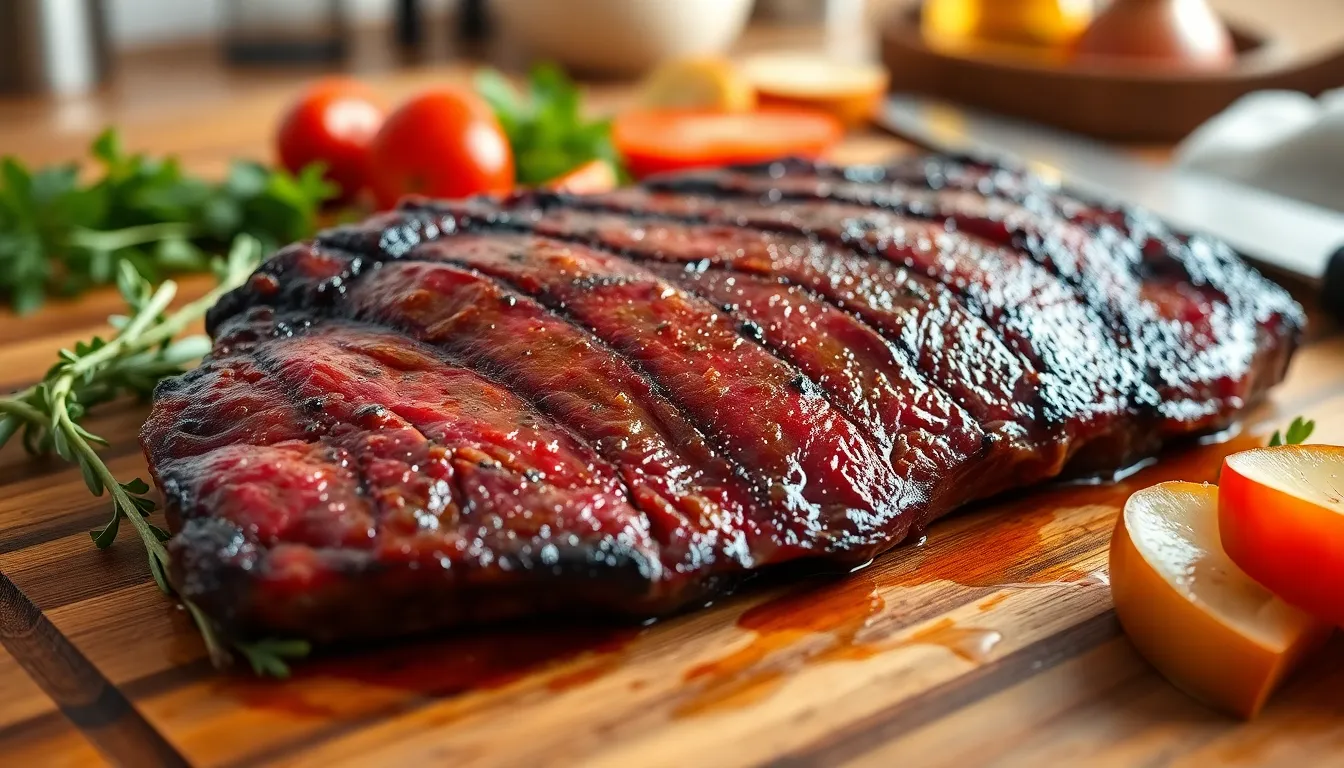
Mastering shaken beef requires attention to three critical elements that separate restaurant-quality results from home cooking disappointments. We’ll guide you through selecting the ideal beef cut, achieving that coveted caramelized crust, and controlling heat for perfectly tender results.
Choosing the Right Cut of Beef
Quality beef forms the foundation of exceptional shaken beef. We recommend investing in premium cuts like filet mignon or tenderloin for the most tender results, though boneless ribeye and strip steak deliver excellent flavor with beautiful marbling.
Budget-conscious cooks can achieve delicious results with sirloin or tri-tip, which offer excellent flavor profiles even though being slightly chewier than premium cuts. These alternatives provide the same satisfying taste experience at a fraction of the cost.
Proper preparation starts with trimming excess fat and cutting your chosen steak into uniform 1-inch cubes. This consistent sizing ensures even cooking throughout, preventing some pieces from overcooking while others remain underdone.
Achieving the Perfect Sear
Your cooking vessel makes all the difference in developing that signature caramelized exterior. We always use heavy pans like cast iron, carbon steel, or stainless steel because they retain and distribute heat evenly for superior searing.
Avoid nonstick pans entirely for this technique, as they cannot reach the high temperatures necessary for proper caramelization. The heavy-bottomed construction of traditional pans creates the intense heat zones essential for restaurant-quality results.
High-smoke point oils like vegetable or neutral oil prevent burning while maintaining the extreme temperatures needed for searing. Preheat your pan on high heat before adding oil, then wait for the oil to shimmer before introducing the beef.
Batch cooking prevents overcrowding, which causes steaming instead of searing. We cook beef cubes in small batches, allowing each piece adequate space to develop its caramelized crust properly.
The shaking technique requires patience initially. Allow beef cubes to sit undisturbed for 20-30 seconds on each side before shaking or turning with tongs, giving each surface time to develop that coveted golden-brown crust.
Temperature Control Tips
High heat throughout the cooking process preserves the beef’s tender interior while creating the characteristic caramelized exterior. We maintain maximum heat settings to achieve quick searing that locks in natural juices.
Total cooking time should never exceed 5 minutes due to the small cube size and intense heat application. This brief cooking window ensures the beef reaches medium rare to medium doneness while maintaining optimal tenderness.
| Cooking Stage | Temperature | Duration |
|---|---|---|
| Initial searing | High heat | 20-30 seconds per side |
| Total cooking time | High heat | 1-2 minutes maximum |
| Final tossing | High heat | 1-2 minutes with vegetables |
Overcooking transforms tender beef into tough, chewy pieces that lose the dish’s signature appeal. We aim for medium rare doneness to preserve the beef’s natural moisture and achieve the perfect texture contrast between the caramelized exterior and juicy interior.
Storage and Reheating Instructions

We know that properly storing your Vietnamese shaken beef ensures you can enjoy those tender, flavorful bites even as leftovers. After cooking, allow the beef to cool completely before transferring it to an airtight container. Our shaken beef stays fresh in the refrigerator for up to 3 days when stored correctly.
When we need to reheat our leftover bò lúc lắc, gentle heat is the key to maintaining its tender texture. We recommend using a nonstick pan over medium heat for 3-4 minutes, stirring occasionally until the beef is warmed through. High heat during reheating will make the beef tough and dry, so we always keep the temperature controlled.
For meal planning purposes, we can marinate the beef up to 1 day in advance and store it in the refrigerator. Before cooking marinated beef that has been chilled, we bring it to room temperature for about 15-20 minutes. This step ensures optimal searing without overcooking the interior.
We avoid freezing cooked shaken beef since the texture becomes compromised when thawed. Fresh preparation always yields the best results for this dish. If we must store the beef longer than 3 days, we prefer to freeze the raw marinated beef instead, which maintains better quality when thawed and cooked fresh.
Our storage containers should seal tightly to prevent the beef from absorbing other refrigerator odors. We separate any leftover vegetables and store them in a different container since they reheat at different rates than the beef.
Variations and Substitutions
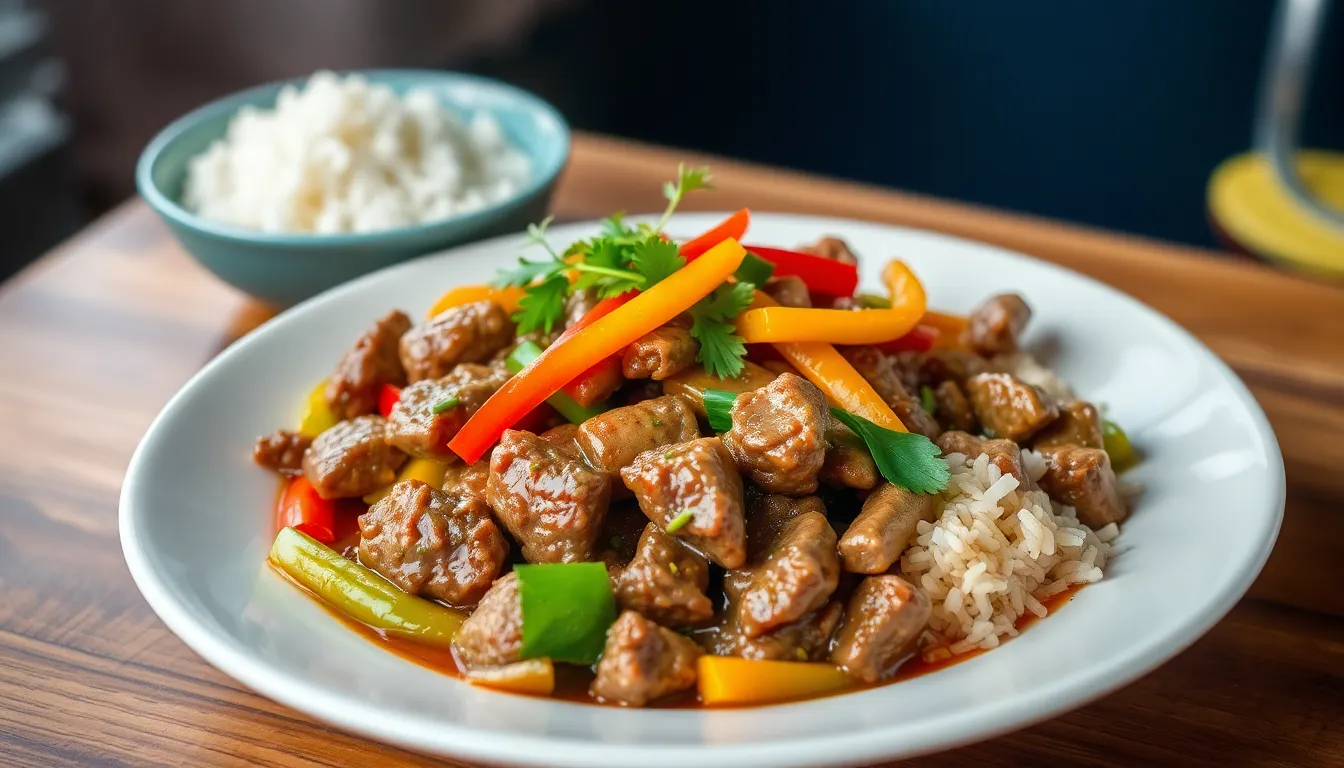
We can easily adapt Vietnamese shaken beef to suit different preferences and budgets without compromising the dish’s authentic flavors. Premium cuts like filet mignon and tenderloin deliver exceptional tenderness but sirloin and tri-tip offer excellent alternatives that maintain the dish’s signature taste at a more affordable price point.
Beef Cut Options
| Cut Type | Tenderness Level | Cooking Time | Price Range |
|---|---|---|---|
| Filet Mignon | Premium | 2-3 minutes | High |
| Tenderloin | Premium | 2-3 minutes | High |
| Ribeye | High | 3-4 minutes | Medium-High |
| Strip Steak | High | 3-4 minutes | Medium |
| Sirloin | Medium | 4-5 minutes | Medium |
| Tri-tip | Medium | 4-5 minutes | Budget-friendly |
We recommend using cornstarch or tapioca starch as a light coating before searing to create an extra crispy crust that holds the marinade beautifully. This technique works particularly well with leaner cuts that benefit from additional texture.
Marinade Modifications
Fish sauce can replace or complement soy sauce for deeper umami notes while sake adds subtle sweetness and helps tenderize the meat. Brown sugar creates richer caramelization than granulated sugar and MSG enhances the savory elements when used sparingly. We suggest experimenting with rice wine vinegar for added brightness or sesame oil for nutty undertones.
Vegetable Alternatives
Red onions provide sharper flavor compared to yellow onions while shallots offer a more delicate taste profile. Bell peppers in various colors add sweetness and crunch while snap peas or sugar snap peas contribute fresh texture. Broccoli florets work well for heartier versions and baby corn adds visual appeal along with mild flavor.
Serving Base Options
Tomato rice serves as an excellent alternative to plain steamed rice by sautéing garlic and tomato paste into cooked jasmine rice with fish sauce seasoning. Fried rice transforms leftovers into a complete meal while cauliflower rice provides a low-carb option that still absorbs the beef’s flavorful juices.
Greens and Accompaniments
Arugula offers peppery notes that complement the sweet marinade while mixed spring greens provide variety in texture and flavor. Butter lettuce creates perfect wraps for handheld eating and watercress adds slight bitterness that balances the dish’s richness.
Sauce Variations
Our traditional lime-salt-pepper dipping sauce can be enhanced with fish sauce for complexity or honey for subtle sweetness. Sriracha mixed with lime juice creates a spicy version while adding fresh herbs like cilantro or mint directly to the sauce provides aromatic depth.
Conclusion
This Vietnamese shaken beef recipe brings restaurant-quality flavors straight to our kitchen with minimal effort and maximum impact. We’ve shown you how the right technique and simple ingredients transform ordinary beef into something truly extraordinary.
The beauty of bò lúc lắc lies in its versatility – whether we’re hosting a dinner party or preparing a quick weeknight meal this dish delivers every time. The combination of high-heat searing and constant motion creates that perfect caramelized crust we all crave.
Now that we’ve mastered the fundamentals there’s no excuse not to fire up that wok and start shaking. Trust us – once you’ve tasted authentic Vietnamese shaken beef made at home you’ll never order takeout the same way again.
Frequently Asked Questions
What is Vietnamese shaken beef (bò lúc lắc)?
Vietnamese shaken beef, or bò lúc lắc, is a popular stir-fry dish featuring tender cubes of beef that are quickly seared at high heat while being constantly tossed in the wok. The beef is marinated in soy sauce, oyster sauce, garlic, and sugar, creating a caramelized exterior with a juicy interior. This “shaking” technique ensures even browning and imparts a distinctive smoky flavor.
How long does it take to make shaken beef?
Shaken beef can be prepared in just 20 minutes from start to finish. The beef requires 10-30 minutes of marinating time, while the actual cooking process takes only a few minutes due to the high-heat searing technique. This makes it perfect for both weeknight dinners and special occasions when you need a restaurant-quality meal quickly.
What type of pan is best for making shaken beef?
A heavy-bottomed pan such as cast iron, carbon steel, or stainless steel is essential for authentic shaken beef. These pans provide superior heat retention and distribution, which is crucial for achieving the characteristic caramelized crust. Nonstick pans should be avoided as they cannot reach the high temperatures required for proper searing.
What cut of beef works best for this dish?
Premium cuts like filet mignon or tenderloin offer the best tenderness, while budget-friendly options like sirloin or tri-tip can also deliver great flavor. The key is cutting the beef into uniform cubes for even cooking. Regardless of the cut chosen, proper preparation and high-heat cooking will ensure delicious results.
How should shaken beef be served?
Traditionally, shaken beef is served over fresh watercress or mixed greens, allowing the hot beef to slightly wilt the vegetables. It’s often accompanied by sliced tomatoes, cucumbers, and onions. Modern variations include serving it over steamed jasmine rice, fried rice, or using it as a filling for bánh mì sandwiches.
Can I make the marinade ahead of time?
Yes, you can marinate the beef up to 24 hours in advance for enhanced flavor. Store the marinated beef in the refrigerator and bring it to room temperature before cooking for optimal results. The longer marination time allows the flavors to penetrate deeper into the meat.
How do I store leftover shaken beef?
Cool the beef completely before storing in an airtight container in the refrigerator for up to three days. For reheating, use gentle heat in a nonstick pan to maintain texture. Avoid freezing cooked beef as it compromises texture; instead, freeze raw marinated beef for better quality when ready to cook.
What makes the “shaking” technique important?
The shaking technique ensures even browning and prevents the beef from sticking to the pan. This constant motion allows all sides of the beef cubes to develop a caramelized crust while maintaining a tender interior. It also helps distribute the marinade evenly and creates the signature smoky flavor known as wok hei.
What vegetables can I substitute in this recipe?
While onions are traditional, you can substitute with bell peppers, snap peas, or broccoli. For serving greens, arugula or mixed lettuce can replace watercress. The key is choosing vegetables that complement the beef’s bold flavors and can handle the high-heat cooking method without becoming overcooked.
Is there a vegetarian version of this dish?
While traditional shaken beef requires meat, you can adapt the technique using firm tofu, mushrooms, or cauliflower florets. Use the same marinade and high-heat cooking method to achieve similar caramelization. However, cooking times may vary depending on the substitute ingredient chosen.







